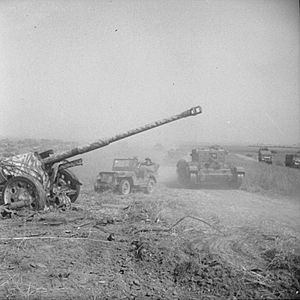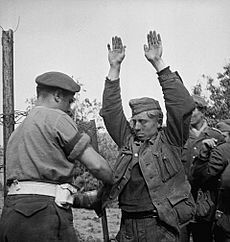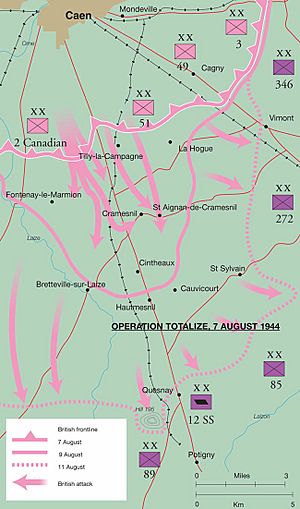Operation Totalize facts for kids
Quick facts for kids Operation Totalize |
|||||||
|---|---|---|---|---|---|---|---|
| Part of Operation Overlord | |||||||
 A Cromwell tank and jeep pass an abandoned German 88 mm anti-tank gun during Operation Totalize, 8 August 1944. |
|||||||
|
|||||||
| Belligerents | |||||||
| Commanders and leaders | |||||||
| Strength | |||||||
| 85,000 men 2,000 aircraft 720 artillery pieces 3 infantry divisions 2 armoured divisions 2 armoured brigades |
3 infantry divisions, 1 SS Panzer division 1 heavy tank battalion At least 74 tanks |
||||||
| Casualties and losses | |||||||
| At least 1,256 146+ tanks |
3,000 casualties At least 45 tanks |
||||||
Operation Totalize was a major attack launched by Allied troops during World War II. It took place from August 8 to 9, 1944, in Normandy, France. The main goal was to break through German defenses south of Caen and push towards the city of Falaise. This move aimed to trap German forces fighting further west.
The attack was led by the First Canadian Army, which included Canadian, British, and Polish soldiers. It was their first big operation. In the early hours of August 8, 1944, Canadian forces used a new tactic: mechanized infantry. This meant infantry soldiers rode in armored vehicles, allowing them to keep up with tanks. They broke through the German front lines and captured important positions.
Two fresh armored divisions were supposed to continue the attack. However, these divisions were new to battle and faced strong German tank counter-attacks. This slowed down the advance. The Allies moved about 9 miles (14 km) but were stopped 7 miles (11 km) north of Falaise. They then had to plan a new attack.
Contents
Why This Battle Happened
Caen was a key city that British forces tried to capture on D-Day. The German defenses around Caen were very strong. For six weeks, both sides fought in a tough, slow battle. British and Canadian forces tried several times to take Caen. They finally captured the northern part of the city on July 9 during Operation Charnwood.
Later, British forces launched Operation Goodwood and Canadian forces launched Operation Atlantic. These operations helped the Allies gain a foothold south of the Orne River. However, the Germans still held Verrières Ridge, a high piece of land about 5 miles (8 km) south of Caen. This ridge was very important because it gave the Germans a good view and strong defensive positions.
The Germans defended Verrières Ridge with some of their toughest units, including SS Panzer divisions. Canadian forces tried to take the ridge in Operation Spring but faced heavy losses. Over 2,800 Canadian soldiers were injured or killed in these attempts. Even though the ridge remained mostly in German hands, the Canadians did gain a small foothold. This allowed them to prepare for Operation Totalize without being easily seen by the Germans.
Meanwhile, on July 25, American forces began Operation Cobra further west. This attack broke through German defenses and allowed American troops to advance quickly. This forced the Germans to move some of their best tank divisions from Verrières Ridge to stop the American advance.
General Bernard Montgomery, who was in charge of the Allied ground forces in Normandy, wanted to attack the eastern side of the front. His goal was to capture Falaise, hoping this would cause the entire German front line to collapse. The First Canadian Army, led by Lieutenant General Harry Crerar, was responsible for this part of the front.
The II Canadian Corps, led by Lieutenant General Guy Simonds, was chosen to launch Operation Totalize. This force included Canadian, British, and Polish infantry and armored divisions.
The Canadian Plan
The German defenses on Verrières Ridge were still very strong. Their front-line positions were well dug-in, with clear views for shooting. They had many anti-tank guns, including powerful 75 mm and 88 mm guns, placed around the villages of Cramesnil and Saint-Aignan-de-Cramesnil. These guns were meant to stop any tank attacks along the Caen–Falaise road.
The German front lines were held by several infantry divisions. The powerful 12th SS Panzer Division Hitlerjugend, with about fifty Tiger tanks, was held in reserve a few miles back.
General Simonds knew that earlier attacks by infantry and artillery had failed to break through these strong German lines. He also knew that previous air bombardments had helped tanks break through, but the infantry couldn't follow fast enough. This left the tanks vulnerable.
To solve this problem, Simonds came up with a new idea: a large attack using mechanized infantry. He had some M7 Priest self-propelled guns, which were no longer needed, converted into "Kangaroo" armored personnel carriers (APCs). These Kangaroos would allow infantry soldiers to ride right alongside the tanks, even over rough ground. This meant the infantry could quickly support the tanks and secure the captured areas.
Simonds also planned to use massive air power. On the night of August 7, RAF bombers would heavily bomb German defenses along a 4-mile (6 km) wide path near the Caen–Falaise road. In the early hours of August 8, two groups of tanks and APCs would advance along this path. These groups would go around the German front-line defenders and capture the main German anti-tank positions by dawn.
The second part of the plan would follow immediately. While other infantry brigades cleared out the remaining German defenders, two fresh armored divisions—the 4th Canadian Armoured Division and the 1st Polish Armoured Division—would move up. US bombers would then attack German reserve positions to prepare for their advance. The final goal was to reach the high ground north of Falaise, about 15 miles (24 km) from the starting point.
The Attack Begins
On the evening of August 7, 1944, the Allied attack forces got ready. They formed six columns, each four vehicles wide, including tanks, Kangaroo APCs, and other armored vehicles. At 11:00 PM, RAF bombers began their attack on German positions. At 11:30 PM, the armored columns started moving forward, following a constant artillery barrage.
Moving in the dark was difficult. Dust from the vehicles made it hard to see, and some drivers got lost. Several vehicles got stuck in bomb craters. Simonds had planned ways to help the columns stay on track, like using radio direction finders and special tracer shells from artillery. But even with these measures, there was still some confusion, and a few vehicles crashed or were knocked out.
Despite the challenges, the attack broke through the German defenses in several places. By dawn, some of the attacking columns had reached their targets. The infantry got out of their Kangaroo APCs very close to their objectives and quickly took over the villages of Cramensnil and Saint-Aignan de Cramesnil. Other columns were delayed by fog and unexpected German resistance. But by noon on August 8, the Allied forces had captured Verrières Ridge. The new methods used by Simonds meant the attackers suffered far fewer losses than they would have in a normal attack.
The Allies were ready to push further south towards Cintheaux. However, Simonds ordered a pause. This was to allow artillery and the 4th Canadian and 1st Polish Armoured Divisions to get into position for the second phase of the operation.
German Counter-Attack
SS Brigadeführer Kurt Meyer, the commander of the 12th SS Panzer Division, had already ordered his infantry to occupy Cintheaux. He also moved two battle groups from his division, including assault guns, infantry, and Tiger tanks, to block the Canadian advance. Shortly after midday, he ordered these groups to counter-attack the leading Allied troops.
At this point, the Allied plan called for more bombing by the US Eighth Air Force. This bombing was supposed to clear the way for the 4th Canadian Armoured Division and the 1st Polish Armoured Division to push south towards Falaise.
The counter-attack by the 12th SS Panzer Division failed. However, Meyer's tanks ended up north of the area that the Eighth Air Force was supposed to bomb. This meant they were not hit by the bombing. These German tanks then slowed down the advance of the 1st Polish Armoured Division. West of the road, German infantry at Cintheaux also held up the Canadian armored forces. Neither the Canadian nor the Polish armored divisions, both new to battle, pushed their attacks as hard as Simonds wanted. They stopped for the night to resupply and rest.
To get the attack moving again, Simonds ordered a column from the 4th Canadian Armoured Division to capture Hill 195. This hill was important because it was halfway between Cintheaux and Falaise. However, this column, called Worthington Force, got lost in the dark. By dawn on August 9, they were 4.5 miles (7 km) east of their target, on a different hill. They fought bravely against German tank counter-attacks all day but suffered heavy losses. Most of their tanks were destroyed or captured.
Because Worthington Force was on the wrong hill, other Allied units sent to help them also went to the wrong place. Eventually, another Allied force captured Hill 195 in a night attack on August 10. But by then, the Germans had gained time to pull back and set up a new defensive line. By August 11, the Allied attack had ended.
What Happened Next

The first part of Operation Totalize was a big success. Even though the two Allied armored divisions faced many challenges pushing towards Falaise, the Allies now held positions directly north of Falaise. They also caused about 1,500 casualties for the Germans.
Major General Rod Keller, commander of the 3rd Canadian Infantry Division, was injured when his headquarters was hit by American bombs. Because of his performance during Totalize, he lost the trust of General Crerar and did not receive any more command positions during the war.
Simonds and Crerar planned a follow-up attack called Operation Tractable. This operation took place between August 14 and 21. On August 21, the Falaise Pocket was finally closed. Canadian and Polish units met up with American troops coming from the south. This marked the end of the Commonwealth forces' involvement in the Battle of Normandy.
See also
- Joe Ekins
- Sydney Valpy Radley-Walters
- Michael Wittmann


